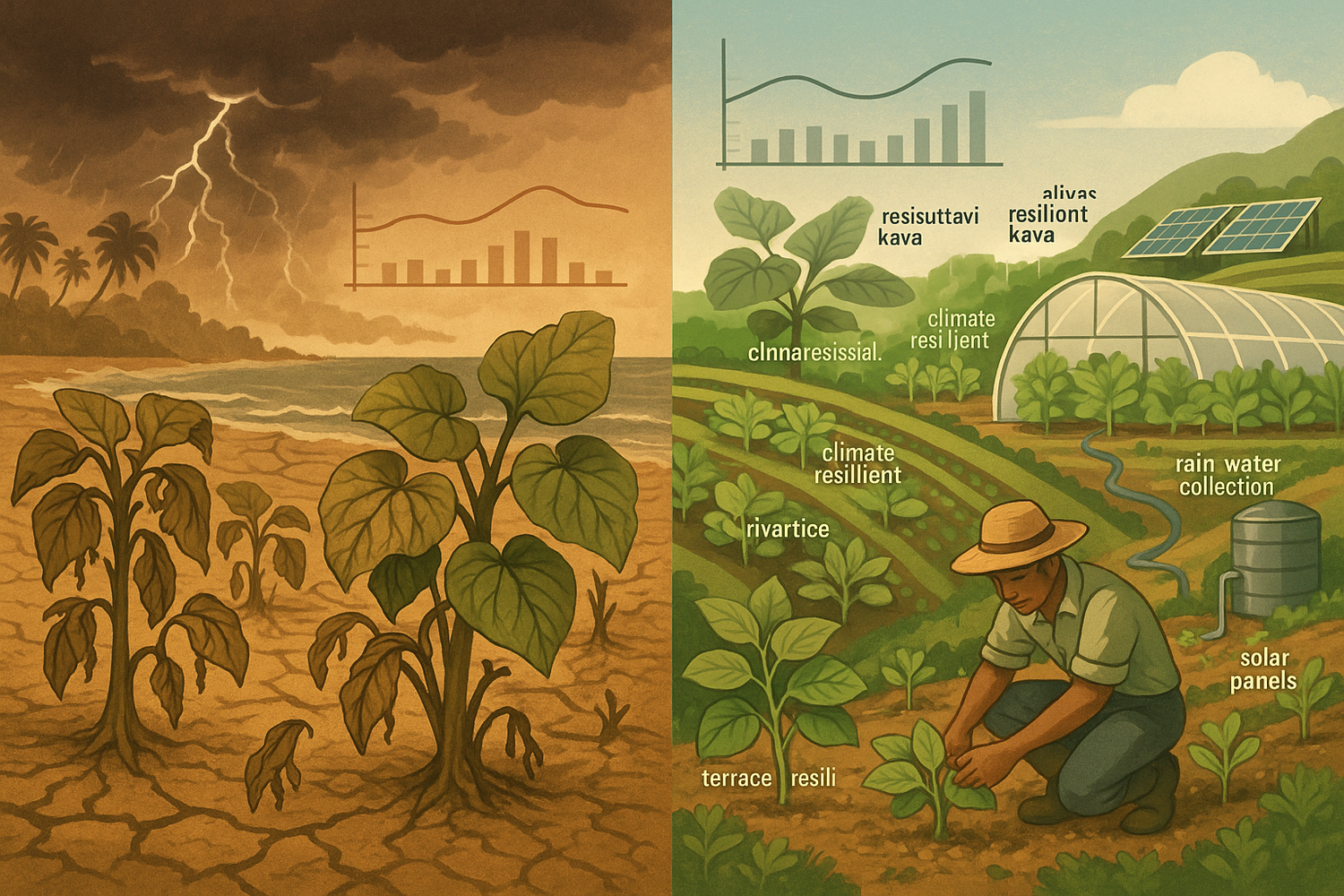Imagine sipping a calming kava drink, blissfully unaware of the turmoil brewing in the fields from which it comes. Kava, cherished for its relaxing properties, faces unprecedented challenges due to climate change that threaten its very survival. In this exploration, we’ll uncover the interplay between environmental conditions and kava farming, offering insights into how growers are adapting and how you, as a consumer, can play a role in nurturing this traditional crop.
The Intricate Dance: Climate Effects on Kava Farming
Kava, celebrated for its relaxing attributes and cultural significance, faces serious challenges in an ever-changing climate. The intricate dance between kava farming and environmental conditions outlines the potential risks growers encounter.
Rising Temperatures: A Double-Edged Sword
What do you think happens when temperatures rise? It's a serious issue for kava. Increases in heat can distort the quality of the kava root. Specifically, higher temperatures can lead to a decrease in its flavor profile and potency. It's not just about getting plants to grow. It's about ensuring they thrive. Dr. Emily Kaul even noted:
"Kava cultivation is highly sensitive to temperature and rainfall, which makes it vulnerable to climate change."
- Roots that require cooler conditions might suffer.
- Altered taste might change consumer preferences.
Rainfall Patterns: The Downpour Dilemma
What about rain? Changing rainfall patterns are not just a minor inconvenience. They affect crop yield significantly. Too much rain can lead to waterlogged roots, while too little can cause drought stress.
This inconsistency forces farmers to adapt rapidly. Those who don't could see their crops diminish. Long-term studies indicate reduced yields, particularly across various Pacific regions. Are these farmers prepared to meet these challenges head-on?
Pest Infestations: New Enemies
Warmer climates don't just affect the plants. They also invite pests that were previously less of a threat. Increased pest infestations pose another substantial challenge for farmers. Imagine looking at your crop and seeing not just the roots but also an array of unwanted guests enjoying the feast.
- More pests lead to an increased need for pesticides.
- This can complicate sustainable farming practices.
Real-World Impact: The Numbers Speak
Research from the Pacific Islands indicates a 30% decrease in kava yield over the past decade due to climate shifts. This reduction isn't merely a statistical anomaly; it's a reflection of larger ecological trends and their impact on the industry. These figures paint a stark picture. If the climate continues to change, we risk losing not just kava, but our cultural practices linked to it.
"If the climate continues to change, we risk losing not just kava, but our cultural practices linked to it." - Professor Tui Aiono
Understanding the Bigger Picture
The ongoing changes in climate have profound effects on kava's farming aspects. These include growth conditions and pest profiles. It means adapting to changing circumstances is now more critical than ever for kava farmers.
As a consumer, you can play a role too. Supporting sustainable kava farming practices can help preserve the conditions necessary for quality kava production. Consider products like the Supramood Goldenglow Elixir that promote eco-friendly cultivation techniques.
For further reading on sustainable practices in kava farming, check out these insightful resources:
Engagement with this topic could prove vital. Together, we can ensure that kava remains a staple of culture and well-being for generations to come.
Environmental Challenges for Farmers: The Struggles Unveiled
Farming isn’t easy, especially for kava farmers facing a host of environmental challenges. These issues can greatly hinder their efforts to produce quality crops. Let’s explore some critical problems.
1. Soil Erosion and Its Consequences
Soil erosion remains a significant threat to kava farms. Have you ever thought about how essential the soil is? It’s not just dirt; it’s the foundation of a farmer’s livelihood. Erosion strips away precious topsoil, which is rich in nutrients. Without it, plants struggle to thrive. According to a survey, 45% of kava farmers reported soil degradation as a critical issue. That’s almost half!
The loss of soil means reduced yields. Without enough nutrients, kava roots, which need the right environment to grow, become less viable. As kava is essential to both local culture and economy, this can have far-reaching consequences.
Issue
Percentage of Farmers Affected
|
Soil Degradation |
45% |
2. Water Scarcity Issues
Water is another major concern. In many rural areas, access to clean water is limited. This makes irrigation difficult. Farmers often rely on rainfall for their crops. When it’s insufficient, the kava doesn’t get enough water. This leads to stunted growth and poor quality. Can you imagine the frustration? You spend time and resources, only to be let down by nature.
Moreover, competition for water resources is fierce. Personal consumption, industrial demands, and agricultural needs all vie for the same finite resource. Often, farmers are left at the bottom of the priority list.
3. Commercial Pressures
The commercial market is relentless. When market demands soar, farmers usually feel compelled to increase production. In many cases, this leads to unsustainable practices. According to John Kamali, an expert in the field,
"The pressures to meet market demands often push farmers towards methods that harm the land."
This may include excessive use of chemical fertilizers or neglecting crop rotation practices, both of which can degrade the land further. So how can you help? Consider opting for sustainably sourced kava products. Check out Supramood's GoldenGlow Elixir. It supports farmers who are committed to environmentally friendly practices.
Wrap Up
As you can see, farmers face an uphill battle. They strive for a balance between sustainable practices and the demands of the market. Each of these challenges can be daunting. But there’s hope. Through awareness and smarter choices, change is possible.
If you're interested in learning more about the impact of climate on kava farming, check out this article and for sustainable farming innovations, take a look at this resource.
Innovations in Kava Farming: Sustainability on the Rise
Kava farming is undergoing a remarkable transformation. You might wonder, what spurred this change? It's the rising need for sustainability. As climate change impacts agricultural practices, innovative methods are paving the way for a resilient future. Here are some of the top innovations in kava farming.
1. Introduction of Agroforestry Practices
Agroforestry involves integrating trees and shrubs into farming systems. This practice is becoming popular among kava farmers. Why? Because it encourages biodiversity. It helps in maintaining a balanced ecosystem.
- Agroforestry enhances soil health. It prevents erosion and improves nutrient cycling.
- Farmers using agroforestry techniques have reported a 25% increase in kava yield.
More trees mean more habitats for beneficial insects and birds. These critters can help control pests, eliminating the need for harsh chemicals. Isn't that exciting? You can support this initiative by choosing products sourced from agroforestry farms.
2. Use of Organic Pest Control Methods
What’s the buzz about organic pest control? It’s a game-changer for kava farmers. By utilizing natural methods, farmers reduce their reliance on chemical fertilizers. This shift leads to healthier kava roots.
- Organic pest control methods are often safer for the environment.
- They promote the health of the local ecosystem.
Are you concerned about what goes into your food and drinks? Choosing organically sourced kava is a simple way to make a difference. Products like the Supramood Goldenglow Elixir are great options that highlight eco-friendly practices.
3. Crop Rotation and Its Benefits
Crop rotation is not just a buzzword; it's a vital practice for sustainable farming. This method involves alternating the types of crops grown in a field each season. For kava farmers, this can lead to better soil health and reduced pest outbreaks. Here’s how:
- Rotating kava with other crops can replenish soil nutrients.
- This practice disrupts pest cycles, leading to fewer infestations.
It’s like giving the soil a break. If you give it time to regenerate, it rewards you with better yields. When farmers apply these methods, they generate a return that's both quantitatively and qualitatively greater.
"Embracing sustainable methods in kava cultivation is not just beneficial; it's the only way forward." - Maria Nasuti
These innovative practices are essential in the face of climate change challenges. They ensure sustainability and profitability for kava farmers. By making informed choices and focusing on eco-friendly options, you can play a part in supporting sustainable kava farming.
For more insights into the challenges kava farmers face, check out Food & Wine and National Geographic. These resources provide an in-depth look at the environmental challenges and innovations transforming the industry.
Supporting Sustainable Kava: The Consumer’s Role
When it comes to kava, many of us enjoy its calming effects and rich history. But did you know that by choosing sustainable kava products, you can play a crucial role in protecting the environment and supporting farming communities? Let's explore how you can make a difference by becoming a conscious consumer.
1. Choosing Certified Sustainable Kava Products
First and foremost, look for certified sustainable kava products. These certifications guarantee that the kava you buy is grown without harmful pesticides or practices that degrade the soil and environment. Choosing certified kava not only supports sustainable farming techniques but also promotes the health of the local ecosystems.
Where can you find such products? Online marketplaces, specialty stores, and brands dedicated to sustainability often showcase their certifications. One such product is Supramood's Goldenglow Elixir, which is crafted with sustainable practices in mind. By supporting brands like this, you help foster a community committed to ecologically sound methods.
2. Understanding the Impact of Your Purchases on Farming Communities
Your purchases have power. When you buy unsustainable kava, you may unintentionally support practices that harm the environment and local communities. On the flip side, supporting sustainable kava directly uplifts farmers. It provides them with fair wages and encourages sustainable habits that further protect natural resources.
Did you know that a recent study found that 60% of consumers are willing to pay more for sustainably sourced kava? This statistic shows that when consumers unite for a common cause, their combined voice can lead to substantial change. You're not just buying a product; you're investing in a sustainable future.
3. Promoting Awareness About Eco-Friendly Kava Options
Another way you can make a difference is by promoting awareness about eco-friendly kava. Talk to your friends, family, or even on social media about the benefits of sustainable kava. Share articles, blog posts, or your own experiences. The more people know, the more support sustainable farming receives.
"Consumers wield enormous power - every small choice can create a ripple effect in supporting sustainable agriculture." - Dr. Leila Fatu
By making your voice heard, you can inspire others to consider their kava choices. Are you ready to be an advocate for sustainable kava? Your efforts can lead to substantial impact in farming communities and help combat the various challenges faced by kava growers.
Conclusion
In conclusion, supporting sustainable kava is not just a choice about a beverage. It's a commitment to *empower farmers*, *protect the environment*, and *promote a better future* for all. When you choose certified sustainable products, you understand the importance of each purchase. Remember, by embracing ecologically friendly kava options, you actively contribute to the fight against climate change and environmental degradation. Take the first step today, and let your choices transform lives.
For more information on sustainable practices in kava cultivation, check out these resources: World Agriculture, Consumer Reports, and Global Responsibility.
TL;DR: Climate change poses significant challenges to kava cultivation, but innovative sustainable farming practices can help mitigate these effects. Consumers can contribute through informed choices that support eco-friendly kava production.







Leave a comment
This site is protected by hCaptcha and the hCaptcha Privacy Policy and Terms of Service apply.